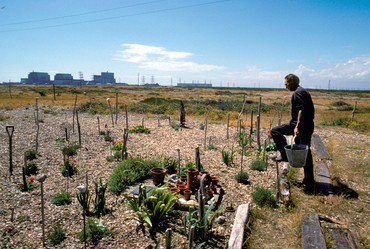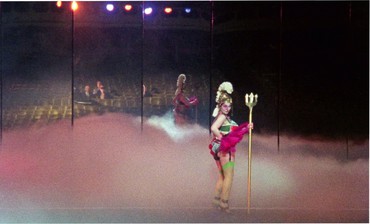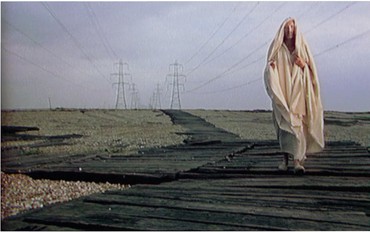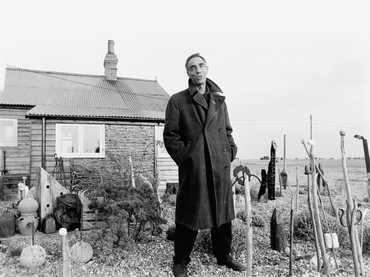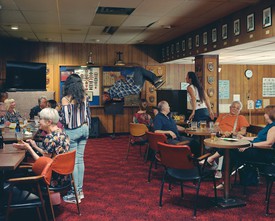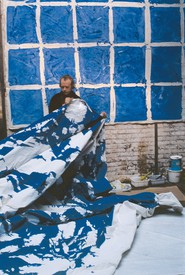
Mark Hudson’s books include Our Grandmothers’ Drums (1989; winner of the Thomas Cook and Somerset Maugham awards), Coming Back Brockens (1994; winner of the AT&T Award), The Music in My Head (1998), and Titian, The Last Days (2009). He has written for the Guardian, the Sunday Times, the Observer, and the Financial Times and was for five years chief art critic of the Daily Telegraph.
On September 22, 1991, Derek Jarman was “canonized” in the garden of his house at Dungeness, on a bare shingle beach overlooked by a nuclear power station at the southeasternmost corner of Britain. Enthroned in golden robes, the forty-nine-year-old filmmaker and artist, his health severely diminished by aids, smiled, his eyes half closed in the autumn sunshine, as “nuns”—members of the Canterbury branch of the American drag performance group the Sisters of Perpetual Indulgence—declared him Saint Derek of the Celluloid Knights of Dungeness. The whimsically camp ceremony culminated in a riotous “laying on of hands” by friends and admirers, a ritual only partly ironic: for those around Jarman, his uncompromising positions on gay rights, his own sexuality, and—not least—his art had lent him a saintly aura. Those present would have done anything to keep this much loved but already mortally ill figure a few months longer on this earth.
I’m walking now toward Jarman’s garden on a blazing Monday in May. It’s the first public holiday since the easing of the covid lockdown and there are plenty of people out on the bare coast road, with the power station looming out of the hazy middle distance and worn scrub rolling away toward the English Channel. This walk has attained something of the air of a pilgrimage. Since Jarman’s death, in 1994, his status as a kind of secular saint has expanded greatly, not only in the LGBT and avant-garde art worlds but across a far wider spectrum of British culture and society. The garden he created around his house, meanwhile, is in the process of becoming a national monument.
On the international stage, Jarman is seen as an important artist filmmaker, probably best known for his 1993 film Blue: simply a single, screen-filling field of glowing ultramarine, over which Jarman weaves a complex soundscape around the cultural and political connotations of his own imminent death. In Britain he is known for a wider range of activities: as the director of feature films, many on queer cultural figures—Caravaggio, Saint Sebastian, Ludwig Wittgenstein—and as a painter, stage designer, diarist, and gay activist. First and foremost, however, Jarman is a charismatic public personality in Britain, a position that seems only to have been strengthened by his death over a quarter century ago. While he personifies his tumultuous times (punk, the ’80s aids crisis and the attendant upsurge in gay consciousness), he also corresponds to a particular British archetype: the gay icon who owes their popularity to the way they perform their homosexuality on the public stage—think of Oscar Wilde, Cecil Beaton, Noël Coward, or David Hockney. Jarman, like Hockney, was a natural on television and radio. Yet where Hockney’s art has long since succumbed to coziness, Jarman’s retains its cachet at the cutting edge. He’s at once a “national treasure” for the solidly middle-class, middle-aged audience of Radio 4—the BBC’s current-affairs channel—and a name to drop among young artists wanting to embrace art’s darkest and most transgressive possibilities.
This contradictory status has come to focus on the garden to which I’m now headed, which became a national cause célèbre earlier this year when it and his house and an area of the surrounding beach were put up for sale. The Art Fund, which acquires works for Britain’s galleries and museums, immediately launched a campaign to save this cultural monument “for the nation”—the sort of attention usually reserved for major old master paintings. Fundraising initiatives, such as costume-designer Sandy Powell’s auctioning of a suit covered in celebrity signatures, made national headlines.
Jarman came to live here in 1986, shortly after he was diagnosed HIV positive. The house, a black-painted fisherman’s cabin, one of many dotted along the coast, looks as though it’s been dumped directly onto the shingle—flint gravel—with the unfenced “garden” sprouting apparently accidentally from the mass of white pebbles: crimson verbena, orange California poppies—which seem to do very well here—and untended masses of spikey gorse stand among circles of phallic stones, pieces of upended driftwood, and rusting metal objects stabbed into the gravel like surreal totems.
Jarman, who saw himself as locked in a bitter struggle with the British cultural mainstream, would have been aghast and amused at the way the British heritage industry has subsumed his personal domestic space, turning it into a popular visiting site, a focus point in the selling and—as he would have seen it—the falsification of the British past. In his films and writings, Jarman rails constantly against the small-minded philistinism—and, naturally, the homophobia—of patriarchal Britain, as embodied in television (“lies and bribery flowing through the National Grid”), the mainstream film industry (“propaganda for Thatcher’s Britain”), and the tawdry spectacle of “the Windsors.” Yet he was aware that in “gardening” he was engaging in perhaps the quintessential British art form. And beneath the invective, there’s a deep feeling in Jarman’s work for an older and more essential Britain that’s been usurped and obscured by the forces of commercialization. In his love-hate relationship with his homeland, Jarman’s own garden became a stage on which his visionary fantasies were played out, while the garden in a larger sense became a key symbol, not least for Britain itself.
The idea of Britain as a garden transcending the boundaries of the wild and the cultivated, the public and the private, is well established in British culture, and it permeates A Journey to Avebury (1971), one of Jarman’s earliest forays into Super 8 film—an “amateur” format that he valued for its ease of use and its painterly qualities. The work’s series of static views of Neolithic stone circles around a Wiltshire village are lent a psychedelic quality by the yellow tinting of the film, while the framing of the farm tracks and clusters of trees around the ancient stones brings to mind “neo-romantic” artists of the interwar period such as Paul Nash, who shared a sense of ancient forces brooding beneath the placid southern-English landscape.
It might seem a jump from this antiquarian home movie to Jubilee, the first punk feature film, a scabrous satire on the music industry made on a shoestring budget six years later. Yet Jubilee starts in an ancient garden (not so far from Avebury), the grounds of an Elizabethan palace, where the magician John Dee—a historical figure and a cypher for Jarman himself—summons Ariel from Shakespeare’s Tempest to transport Elizabeth I into the future. The world they arrive in isn’t the euphoric real-life 1977, where the Queen’s Silver Jubilee celebrations were lampooned in the Sex Pistols’ “God Save the Queen,” but a skewed, dystopian wasteland of burning cars and graffiti. The Queen has been killed in a random mugging and Buckingham Palace is being turned into a music venue—a nightmare inversion of William Blake’s “green and pleasant land,” the idealized garden of the collective British imagination.
The monarch’s crown becomes the plaything of a band of murderous, nihilistic female punks led by Amyl Nitrate, played by Jordan, assistant in Malcolm McLaren and Vivienne Westwood’s boutique Sex—perhaps the ultimate punk, “the original Sex Pistol,” in Jarman’s phrase. In a typically paradoxical gesture, Jordan also plays Britannia, symbolic embodiment of Britain. In a key scene, Amyl reads from a self-penned history of Britain: “It all began with William the Conqueror . . . dividing the land into theirs and ours. They lived in manors and ate beef at fat tables, whilst the poor lived in houses minding the cows on a bowl of porridge.” If that’s hardly the most sophisticated analysis of British history—even as satire—it confirms the sense, pervasive in Jarman’s work, of an Eden riven by primordial and still unreconciled class and culture conflicts.
At the end of Jubilee, Jarman’s “heroines” escape into what he describes in his book Dancing Ledge (1984) as “a dream England of the past: the England of stately homes, which are the indispensable props for the British way of life. . . . Any film or TV series that has one is halfway to success. Private schools are housed in them, so the children of the wealthy get a taste for them young.” At Longleat House, the popular Wiltshire tourist destination where these sequences were filmed, Jarman sees “centuries-old oaks”—an ancient symbol of Britain—“wrapped in barbed wire and plastic,” apparently for their own protection: the English garden subject to a kind of totalitarian commercialism. It is only when his characters arrive on unspoiled cliff tops in Dorset, where Jarman holidayed as a child, that they appear able to breathe. Often with Jarman, you feel that the authentic England is best accessed through his own autobiography.
In The Last of England (1987), Jarman’s Super 8 camera tracks past rows of suburban houses, fenced off and apparently waiting demolition: the ruins of the world of Little English houses and gardens that covered the wider garden of England in the industrial era. While Jarman longs to escape this conformist England, he now feels sympathy for it as much as revulsion, as he sees it steamrollered by something far worse: the untrammeled monetarism of Margaret Thatcher’s Britain. Seated at his worktable in a white skullcap, Jarman appears the embodiment of his alter ego John Dee—“the magus, inventor and universal man”—as he controls the film’s action, writing and drawing it as we watch, or so we’re made to feel. The blizzard of flickering, superimposed, distressed imagery, slowed down or sped up, with clouds streaming through tainted skies over Britain’s ruined cities, creates a sense of wild, accelerated entropy.
Old home movies and faux newsreel footage are collaged together, with Jarman’s handheld Super 8 photography blown up to fabulously grainy 35mm, as though he were painting with his “amateur” camera directly onto the commercial cinema screen—and thanks to the notoriety of Caravaggio, released the previous year, the film received far wider distribution than you’d expect for an experimental film. Jarman fuses the ancient and the modern, high culture and low, the avant-garde and the populist, more fully than any filmmaker I can think of, and not least through his instinct for picking performers who would become stars in the wider world, their glamour reflecting back on him: actors Tilda Swinton and Sean Bean, musician Adam Ant, as well as Toyah Willcox, star of Jubilee and The Tempest (1979), who went on to a prominent pop career in Britain. David Bowie, who was to have starred in the aborted nuclear thriller Neutron and visited Jarman at the height of his own coke-fueled paranoia, was unnerved by the sight of a skull on the filmmaker’s desk, taking him for a more than merely cinematic magician.
Finally, in The Garden (1990), the cinematic alchemist lies slumped across his desk in his Dungeness house, as though dreaming his own apotheosis as it’s played out in his garden and the surrounding wasteland. Live-action filming is intercut with green-screened imagery, so that the sky at moments resembles an immense television screen. Christ with his stigmata wanders beneath the power lines beside the nearby power station, like some lost figure from a film by Pier Paolo Pasolini (a key influence on Jarman), while the Devil, a sinister dildo-wielding leather man, crawls through the shrubbery outside. While Jarman claimed that conventional religion had nothing to offer him as a gay man, the film bursts with Christian iconography. The scrub between the house and the sea becomes the stage for a delirious religious/erotic phantasmagoria, with the Madonna, played by Swinton, presiding over the twelve Apostles, seated at a long table and represented variously by a group of elderly women and twelve cane-wielding school masters who stand, we assume, for patriarchal, academic authority. A small boy, clearly representing Jarman himself, is obliged to dance for them.
In the driftwood-strewn Eden of Jarman’s garden, a young male couple have taken up residence. As often in Jarman’s films, the unself-conscious beauty of the young male is presented as a state of primitive innocence, from which Jarman, the self-regarding artist, is necessarily excluded. In a telling moment, one of the young lovers looks up and pushes away Jarman’s prying camera. In the film’s climactic sequence, the pair are humiliated (a moment recalling the Crowning with Thorns) before being beaten by the servants of the British state, a group of satanically cackling policemen—or that’s certainly what they look like—wearing sinister Santa Claus costumes over their dark uniforms, as though attending some gruesome seasonal celebration. Jarman, meanwhile, carries on gardening, pruning shrubs and digging in compost, as his own end approaches.
Jarman may have loathed the British class system but he completely understood his relation to it: a bohemian gay-activist dissident, he was inescapably a product of the lower end of the upper middle class—one born with the right to speak and be heard. I doubt it ever seriously occurred to Jarman to doubt the importance of his work. And it says a great deal about the depth of his understanding of the chemistry of British society that he would have realized exactly how his house and garden—and to a degree the rest of his work—would be accommodated by the British mainstream.
Yet much in that work still challenges. There are moments of silliness in Jarman’s films, a tendency toward facile horror and adolescent overstatement that at times brings to mind his early mentor Ken Russell. Yet it’s precisely that lack of conventional good taste that keeps his art relevant; the fact that it’s difficult to pick apart what’s inexcusably sentimental from what’s righteously abrasive keeps you interested. In a world where art is dominated by timid, curator-led formalism, and where innovation in the cinema proceeds painfully gradually, Jarman’s larger-than-life individualism stands out. Approaching half a century on from their inception, his filmic struggles with his homeland still feel fresh and magnificently uncomfortable.


